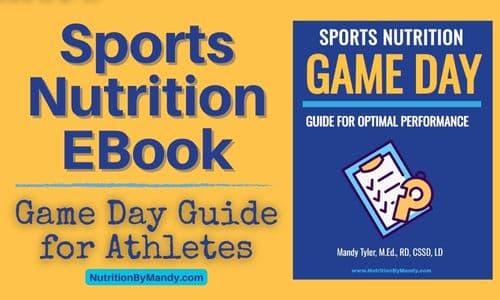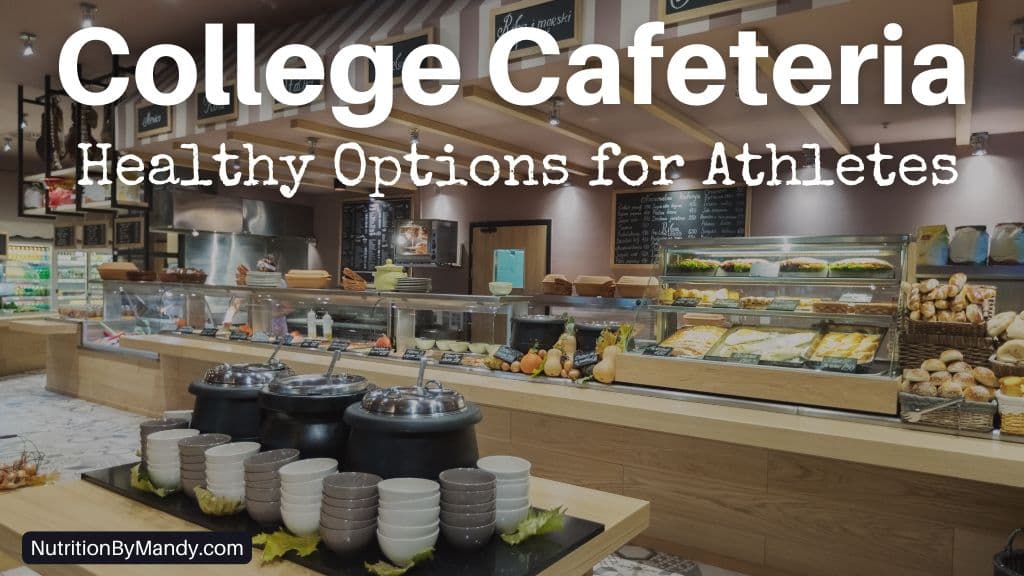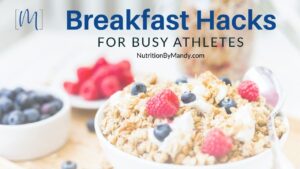Last Updated on November 10, 2024 by Mandy Tyler, M.Ed., RD, CSSD, LD
As a sports dietitian, I find it valuable to take college athletes on a tour of the cafeteria to assist them with making healthier food choices.
Teaching athletes how to navigate the cafeteria can help ensure that they are fueled to perform at their best in the classroom and on the court.
Let’s explore some of the key tips and recommendations I share with athletes on making healthy food choices at their college cafeteria.
Tips for Making Healthy Food Choices at the College Cafeteria
When heading to the cafeteria, athletes should keep the following key tips in mind for building a healthy plate that supports their sports nutrition needs.
Focus on Carbohydrate-Rich Foods
Carbohydrates should be at the foundation of an athlete’s sports nutrition meal plan. Similar to gas in a car, carbohydrates provide athletes with the energy needed to perform at their best.
Athletes can add carbohydrates to their meals from a variety of food groups, including:
- Grains: Bread, bagels, pasta, rice, quinoa
- Fruit: Fresh, dried, frozen, canned in natural juices, applesauce, 100% fruit juice
- Starchy vegetables: Potatoes, sweet potatoes, winter squash, corn, beans, peas
- Milk and yogurt
On intense training/competition days, athletes should aim to fill half of their plates with carbohydrate-rich foods to support their high levels of activity (1).
When athletes have days off for recovery, they can reduce the amount of carbohydrates on their plates with. By fluctuating the amount of carbohydrates based on daily activity levels, athletes can tailor their daily meal plan to meet their performance needs.
Include Protein with College Cafeteria Meals
Consuming protein throughout the day with meals and snacks is important for athletes. Protein supports athletes with building and maintaining lean muscle mass.
Ideas for sources of protein that athletes can include in their meals at the cafeteria include:
- Eggs
- Chicken, turkey, seafood, pork, lean cuts of red meat
- Milk, Greek yogurt, cheese, cottage cheese
- Beans and legumes
- Nuts and nut butters
- Quinoa
- Soy milk, tofu
Add in Anti-Inflammatory Foods
When building a healthy plate at the college cafeteria, athletes should also include foods that can help reduce inflammation and support recovery.
Some of my top anti-inflammatory food choices for athletes include:
- Berries
- Cherries
- Avocados
- Dark green leafy vegetables
- Tomatoes, broccoli, bell peppers
- Nuts and seeds
- Fatty fish such as salmon and tuna
- Olives and olive oil
Survey the College Cafeteria Food Choices
Prior to building a plate at the cafeteria, I encourage athletes to take time to walk around all the food stations to see what food choices are available that day.
Most college cafeterias are set-up to include multiple food stations, such as:
- Grill
- Deli line
- Home cooking
- Pizza and pasta
- Soup and salad bar
When eating at the cafeteria, athletes should remember that they do not have to build their meal from one station. Instead, they can select an entrée from one station and side items from other stations to build a healthy plate.
By walking around the cafeteria prior to building a plate, athletes can identify which components of their meal they want to select from each station.

College Cafeteria Food Choices: Have a Back-Up Plan
Finally, I encourage athletes to have a back-up plan in place for a quick healthy meal that they can enjoy at the cafeteria when options seem limited.
For example, consider getting pasta with marinara from the pasta station, chicken from the grill, and a side salad from the salad bar.
Other examples may include:
- Scrambled eggs, whole wheat toast, Greek yogurt with fruit, 100% fruit juice
- Bagel with nut butter, banana, low-fat milk
- Turkey sandwich on wheat bread, fruit salad, fresh veggies from the salad bar, low-fat milk
College Cafeteria Food: Healthy Choices for Athletes
Now that you have a gameplan in place for selecting menu items at the cafeteria, let’s explore each section of the college cafeteria to identify healthy food choices.
Healthy College Cafeteria Breakfast Food Choices
College athletes should make it a priority to start their day with breakfast. Heading to the cafeteria after morning practice and before class can help ensure athletes have the energy needed for the day ahead.
Athletes should be mindful to limit foods high in saturated fat at breakfast, such as bacon, pastries, and gravy.
Saturated fat is associated with increased inflammation in the body (2). Thus, foods high in saturated fat are less healthy choices for athletes.
The chart below provides ideas for the best breakfast options at the college cafeteria for athletes as well as options to limit.
| Best Breakfast Options | Breakfast Options to Limit |
| Oatmeal, whole grain breakfast cereals | Sugary breakfast cereals |
| English muffins, bagels, toast | Donuts, pastries |
| French toast, pancakes | Biscuits, croissants |
| Eggs, turkey sausage, ham | Bacon, sausage |
| Greek yogurt, cottage cheese, fresh fruit | Fried hashbrown potatoes |
| Nut butter, jelly, fruit preserves | Gravy, cream cheese, butter |
| Low-fat milk, 100% juice, fruit smoothie | Sugary coffee drinks |
College Cafeteria Food: Lunch and Dinner Options
I find many college athletes do well with building a healthy breakfast at the cafeteria. However, they often struggle with finding the best options at lunch and dinner to support their nutrition needs.
Below are ideas for healthy lunch and dinner choices that you can commonly find in college cafeterias.
College Cafeteria: Home Cooked Station
On the home cooked line, athletes can often find lean sources of protein, potatoes, and rice, well as cooked vegetable options.
When navigating the home cooked station, athletes should keep the following tips in mind:
- Opt for high-quality proteins – Healthy choices include chicken or turkey breast (without skin), pork chops, seafood, and lean cuts of red meat.
- Add on carbohydrates – Rice, quinoa, mashed potatoes, baked potatoes, sweet potatoes, corn, beans, and peas are all great options.
- Limit fried foods – This includes items such as chicken fried steak, fried fish, and fried vegetables (potatoes, okra).
- Request the sauce on the side – If the entrée or vegetable comes topped with a gravy or sauce, athletes should request it be served on the side so they can control the amount added.
The majority of the time, I find that there are several items available at the home cooked station that athletes can add to their meals.
College Cafeteria: Grill
Many college cafeterias feature a grill, where students can get hamburgers, chicken sandwiches, grilled cheese sandwiches, and hot dogs.
Similar to the homecooked line, I encourage athletes to limit their selection of fried food items. In addition, I suggest choosing high-quality protein options that contain limited saturated fat.
- Best choices at the grill: Grilled chicken sandwich, single-patty hamburger, turkey hotdog, grilled cheese, sweet potato fries
- Choices to limit at the grill: French fries, tater tots, onion rings, fried chicken sandwich, fried fish sandwich, regular hotdog
I encourage athletes to top their grilled chicken sandwich or burger with a variety of fresh veggie toppings. If options are not available at the grill, they can head to the deli station or salad bar to get the veggie toppings there.
Athletes should also remember that they can order just the grilled chicken breast or hamburger patty to enjoy as part of their meal.
They can then select healthy side items such as rice, a baked potato, cooked vegetables, fruit, or a side salad from other cafeteria stations to enjoy with the meal.
College Cafeteria: Deli Station
The deli station can be a convenient option, especially when looking for a quick meal to grab between classes.
I often remind athletes that if nothing looks appealing on the day’s menu, they can always build a nutritious sandwich at the deli.
Tips for building a healthy deli sandwich include:
- Whole Grain Carbs: Select whole grain bread, wraps, and sandwich buns. Whole grains contain fiber, vitamins, and minerals, making them a nutritious addition to an athlete’s diet.
- Protein: Top protein sources for an athlete’s sandwich include turkey, chicken, ham, or roast beef. Italian meats, such as salami and pepperoni, tend to be higher in saturated fat and are less healthy choices.
- Veggie Toppings: Pile a variety of vegetable toppings onto your sandwich.
- Healthy Fats: Choose healthy sources of unsaturated fats to enjoy on your sandwich such as sliced avocado, guacamole, olive oil, and vinaigrette-based dressings.
Along with the sandwich, athletes should choose a healthy side item. Options such as fresh fruit, a side salad, steamed vegetables, beans, or a fruit and yogurt parfait are all nutritious options.

College Cafeteria: Pizza and Pasta Station
Pizza is a common food item available at college cafeterias. Athletes can enjoy a slice of pizza as part of their meal plan; I just encourage them to select healthier choices when possible.
- Best Pizza Topping Choices: Canadian bacon, ham, grilled chicken, variety of veggie toppings, pineapple
- Pizza Topping Choices to Limit: Pepperoni, sausage, bacon
Athletes should also remember moderation when it comes to pizza. They can enjoy a slice or two and then round out the meal with a side salad and fresh fruit.
When it comes to pasta, I encourage athletes to choose either marinara (tomato) sauce or pesto. Alfredo and other cheese sauces tend to be higher in saturated fat and less healthy options.
Pro Tip If protein options are not available with the pasta, consider heading to the grill to get a grilled chicken breast to enjoy with your pasta.
College Cafeteria: Soup and Salad Bar
I find that most college cafeterias have a salad bar available for students. Building a healthy salad to enjoy with meals can be a convenient way for athletes to boost their intake of vitamins, minerals, and fiber.
Tips for building a healthy salad include:
- Base of leafy greens: Romaine, spinach, kale, arugula
- Add on colorful veggies: Tomatoes, carrots, cucumbers, bell peppers, celery, mushrooms
- Include protein: Beans, hard-boiled eggs, nuts, seeds, diced turkey or ham, cottage cheese
- Side of fruit: Sliced melon, strawberries, grapes, orange wedges, apples, banana, dried fruit
Athletes should be mindful about the amount of salad dressing they add to their salads. Remember, the goal is to have salad topped with limited dressing, not dressing with a little salad.
For a healthier choice I recommend athletes top their salads with olive oil and other vinaigrette-based dressings.

Healthy College Cafeteria Soup Options for Athletes
When it comes to soups, I encourage athletes to choose broth-based soups. Soups made with cheese or cream (i.e., baked potato soup, cheddar broccoli soup) tend to be higher in saturated fat.
Some of my favorite soup choices for athletes include:
- Chicken noodle
- Chicken and rice
- Chicken tortilla
- Beef vegetable
- Minestrone
- Pasta fagioli
If rice is available at any of the cafeteria stations, athletes can add it to the soup to boost the carbohydrate content of the meal. For example, stirring rice pilaf into beef vegetable soup or Spanish rice into chicken tortilla soup are both tasty options.
College Cafeteria: Beverage Station
With endless refills available, it can be easy for athletes to overindulge on sugar-sweetened drinks, such as soda, sweet tea, and fruit punch.
Sugar-sweetened drinks provide calories with limited other nutritional benefits such as vitamins and minerals. Instead, of sugary drinks, I encourage athletes to select nutritious beverages that support their daily hydration needs.
Best beverage options for athletes at the college cafeteria include:
- Water
- Low-fat milk
- 100% fruit or vegetable juice
- Unsweet tea
Pro Tip: Athletes can add flavor to their glass of water with a wedge of lemon or lime or a slice of cucumber from the salad bar.
College Cafeteria Food: Desserts
When it comes to deserts at the college cafeteria, athletes should remember moderation. Enjoying a freshly baked cookie or favorite dessert can absolutely fit into an athlete’s meal plan.
I like to share with athletes the “80/20 Rule” for healthy eating – the goal being to aim to make healthy food choices 80% of the time. The other 20% of the time, it is okay for athletes to enjoy their favorite, less healthy foods, in moderation.
College Cafeteria Food: Healthy Options for Athletes
You are now set with ideas for navigating the college cafeteria to find healthy food options for athletes.
For additional sports nutrition tips for dining out, make sure to check out my blog on healthy fast-food choices for athletes.
Join the Nutrition By Mandy Email List & Get a Free Athlete’s Grocery List
Click HERE to join the Nutrition By Mandy e-mail list. When you join you will receive a free athlete’s grocery list to print and take with you to the store.
About the Author
Mandy Tyler is a Sports Dietitian Nutritionist in the San Antonio, TX area. She is a Registered and Licensed Dietitian, a Board-Certified Specialist in Sports Dietetics, a Licensed Athletic Trainer, and is a Certified Exercise Physiologist through the American College of Sports Medicine. Mandy has experience working with athletes at the high school, collegiate, and professional levels. She believes the key to reaching one’s full potential, both in everyday life and in sports performance, relies on a healthy nutritional foundation.

If you are looking to take your performance to the next level, make sure to check out my new Sports Nutrition Game Day Guide. This downloadable guide is written to help athletes develop an individualized plan to achieve peak performance on game day.





